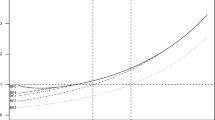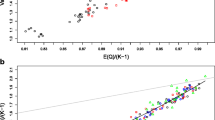Summary
The conventional procedures for a common odds ratio in multiple 2×2 tables are explored and critiqued. Three types of linear approximation to the likelihood equations under some models of common measures of association are used to derive the popular conventional estimators and test statistics. Some of them are derived using the model of the common standardized difference which is an unacceptable measure. The derivation provides us with some characteristics of the procedures. The advantages of procedures based on the conditional and unconditional likelihoods are discussed.
Similar content being viewed by others
References
Andersen, E. B. (1970). Asymptotic properties of conditional maximum-likelihood estimators,J. R. Statist. Soc., B,32, 283–301.
Anscombe, F. J. (1956). On estimating binomial response relations,Biometrika,43, 461–464.
Birch, M. W. (1964). The detection of partial association I: The 2×2 case,J. R. Statist. Soc., B,26, 313–324.
Breslow, N. E. (1981). Odds ratio estimators when the data are sparse,Biometrika,68, 73–84.
Breslow, N. E. and Liang, K. Y. (1982). The variance of the Mantel-Haenszel estimator,Biometrics,38, 943–952.
Cochran, W. G. (1954). Some methods for strengthening the common χ2 tests,Biometrics,10, 417–451.
Cox, D. R. (1970).The Analysis of Binary Data, Methuen and Co., London.
Day, N. E. and Byar, D. P. (1979). Testing hypotheses in case-control studies—equivalence of Mantel-Haenszel statistics and logistic score tests,Biometrics,35, 623–630.
Farewell, V. T. and Prentice, R. L. (1980). The approximation of partial likelihood with emphasis on case-control studies,Biometrika,67, 273–278.
Fleiss, J. L. (1970). On the asserted invariance of the odds ratio,Brit. J. Prev. Soc. Med.,24, 45–46.
Fleiss, J. L. (1981).Statistical Methods for Rates and Proportions, 2nd ed., Wiley, New York.
Gart, J. J. (1971). The comparison of proportions: A review of significant tests, confidence intervals and adjustments for stratification,Rev. Int. Statist. Inst.,39, 148–169.
Goodman, L. A. (1969). On partitioning χ2 and detecting partial association in three-way contingency tables,J. R. Statist. Soc. B,31, 486–498.
Haldane, J. B. S. (1955). The estimation and significance of the logarithm of a ratio of frequencies,Ann. Hum. Genet.,20, 309–311.
Halperin, M. et al. (1977). Testing for interaction in anI×J×K contingency table,Biometrika,64, 271–275.
Harkness, W. L. (1965). Properties of the extended hypergeometric distribution,Ann. Math. Statist.,36, 938–945.
Hauck, W. W. (1979). The large sample variance of the Mantel-Haenszel estimator of a common odds ratio,Biometrics,35, 817–819.
Hauck, W. W., Anderson, S. and Leahy, F. L. (1982). Finite-sample properties of some old and some new estimators of a common odds ratio from multiple 2×2 tables,J. Amer. Statist. Ass.,77, 145–152.
Hitchcock, S. E. (1962). A note on the estimation of the parameters of the logistic function, using the minimum logit χ2 method,Biometrika,49, 250–255.
Lubin, J. H. (1981). An empirical evaluation of the use of conditional and unconditional likelihoods for case-control data,Biometrika,68, 567–571.
Mantel, N. and Haenszel, W. (1959). Statistical aspects of the analysis of data from retrospective studies of disease,J. Nat. Cancer Inst.,22, 719–748.
Mantel, N., Brown, C. and Byar, D. D. (1977). Tests for homogeneity of effect in an epidemiologic investigation,Amer. J. Epidemiol.,106, 125–129.
Mckinlay, S. M. (1975). The effect of bias on estimators of relative risk for pairmatched and stratified samples,J. Amer. Statist. Ass.,70, 859–864.
Mckinlay, S. M. (1978). The effect of nonzero second-order interaction on combined estimators of the odds ratio,Biometrika,65, 191–202.
Nelder, J. A. and Wedderburn, R. W. M. (1972). Generalized linear models,J. R. Statist. Soc., A,135, 370–384.
Radhakrishna, S. (1965). Combination of results from several 2×2 contingency tables,Biometrics,21, 86–98.
Woolf, B. (1955). On estimating the relationship between blood group and disease,Ann. Hum. Genet.,19, 251–253.
Yanagimoto, T. and Kamakura, T. (1984). The maximum full and partial likelihood estimators in the proportional hazard models,Ann. Inst. Statist. Math., A,36, 363–373.
Yates, F. (1955). The use of transformations and maximum likelihood in the analysis of quantal experiments involving two treatments,Biometrika,42, 382–411.
Author information
Authors and Affiliations
Additional information
The Institute of Statistical Mathematics
About this article
Cite this article
Yanagimoto, T., Yamamoto, E. Simple linear approximations to the likelihood equation for combining evidence in multiple 2×2 tables: A critique of conventional procedures. Ann Inst Stat Math 37, 37–49 (1985). https://doi.org/10.1007/BF02481079
Received:
Revised:
Published:
Issue Date:
DOI: https://doi.org/10.1007/BF02481079




